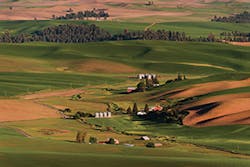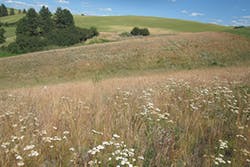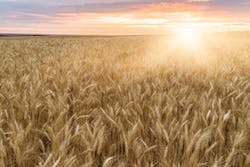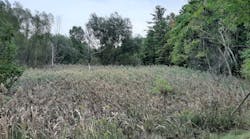Seeding for Progress and Restoration
Dunes of Ancient Origin
The Palouse region of eastern Washington is known as one of the most fertile expanses of land in the world, with rich topsoil plunging to a depth of 100 feet or more. As Kurt Merg, vegetation ecologist for the Washington Department of Fish and Wildlife, explains, it is one of the best wheat growing regions on the planet. He notes that the abundance of soil resulted from Pleistocene winds, which carried fine particulates north and east into what is now eastern Washington from what is now Oregon, eventually accumulating in dune-like hills. Precipitation arrives on these hills mostly in winter, with annual totals approximately doubling (14 to 30 inches) from the western to eastern margins of the region, respectively. Much of this water is captured in the deep Palouse soils. Less than 1% of Palouse Prairie remains, making it one of the most imperiled habitats on Earth. Most of the Palouse is now devoted to cultivation of row crops, especially wheat.
Cultivation of wheat began with horse-drawn implements on the Palouse in the last few decades of the 19th century and was at first limited to valley bottoms. Increasing mechanization through the 20th century enabled tillage on ever-steeper slopes and over an ever-larger area. The result was erosion of soil into gullies and then into watercourses. Obvious evidence of erosion in the uplands was quickly erased by tillage, or covered up by growing crops. In the latter half of the 20th century, erosion accelerated on the Palouse as it became possible to till virtually “straight uphill” and more marginal lands were pressed into production.
The intensive agricultural regime, propelled by high-powered engines, synthetic fertilizers, and advances in crop breeding, pushed yields higher. Yields, however, depended increasingly on costly inputs that, in combination with crop surpluses and collapse of the US export market, pushed farm debt to the levels that led to the Farm Crisis of the 1980s. Farmers suddenly were in deep financial trouble, and their future was clouded by unsustainable farming practices, evident in “rivers that ran chocolate brown with soil in early spring, and clay layers peeking through the surface of over-tilled hilltops. Erosion was a significant problem,” says Merg.
With the Food Security Act of 1985, Congress delivered broad financial aid to farmers that included the Conservation Reserve Program (CRP), which pays farmers to plant highly erodible fields with perennial plants that hold soil in place and so protect water quality while providing habitat for wildlife. The CRP had its roots in the Soil Bank program that began in the 1950s, but was much larger; the CRP encompassed 36.8 million acres nationwide at its peak in 2007. It was a major turning point in stewardship of the land in agricultural regions of the country.
Since then, additional programs and policy initiatives have augmented the CRP and encouraged farmers, by various means, to preserve the soil and set aside acreage for nature. Merg provides technical assistance to the team of biologists in the Department of Fish and Wildlife that helps farmers understand how they can benefit from programs such as the CRP and implement those programs to provide enduring habitat for fish and wildlife.
Aiming for Wildlife
Merg notes that the CRP was initially aimed at delivering aid to farmers while also meeting three conservation goals in equal measure: preserving the soil, protecting water quality, and providing wildlife habitat. Eventually, however, the CRP proved to be doing a better job of holding soil and protecting water quality than providing wildlife habitat. In practical terms, says Merg, the CRP contracts, including projects he worked on early in his own career, prescribed seed mixes of mostly non-native species and native species cultivars, which are variants of native species that have been bred for uniform physical traits. On the Palouse, most CRP stands included at least one non-native grass that grows by underground stems that produce lateral shoots and roots, rather than by producing seed as the native bunchgrasses do. These non-native grasses took over CRP stands, resulting in “dense tangles of one or two aggressive grasses that lock soil in place and so protect water quality, but that provide little of the diversity that makes habitat valuable to wildlife,” he says.
To address this imbalance, Congress authorized, in the 2008 Farm Bill, the State Acres for Wildlife Enhancement (SAFE) practice within CRP. SAFE is a flexible, results-oriented, locally led initiative that creates a continuous CRP enrollment opportunity for producers to address wildlife habitat resource concerns for specific species in a targeted region. The first SAFE programs were approved in 2008 and, to date, about 1.45 million acres are enrolled in 106 CRP SAFE projects in 36 states and Puerto Rico. Merg helped to design the Palouse Prairie SAFE project, which, unlike many other SAFE projects, is intended to augment the prairie for its own sake, because less than 1% of Palouse Prairie is thought to remain, as well as to support wildlife that depends on it.
Although Merg has personally collected seed in the field, he admits his total would be insufficient to supply even one of the typical CRP SAFE projects his agency designs, which range from 5 acres to hundreds of acres per parcel. “The supply of seed throughout the West is a real bottleneck in my agency’s own stewardship effort on about 1 million acres of public land,” he says. “Consequently, we have recently modified a key procurement contract to include wild collection and seed increase. In years when natural seed production is better than average, we can now get a collection team into the field when the seed is available. Then we hand the seed off to a proven grower to increase and store for us to use when we need it—say, after a large wildfire on one of our wildlife areas.”
To be certified as local genotype seeds in the SAFE program, mixes must conform to some stringent requirements. Among the standards that must be met, “seed mixes must contain no weeds and no non-crop perennial grasses,” says Merg. “When dealing in locally adapted genotypes, that labeling is very important. Each variety provided must be source identified, with documentation specifying where the seed was grown and how many generations were grown in captivity.”
Washington companies such as BFI Native Seeds are providing up to 30 or 40 varieties of seed for local farmers. BFI follows the Association of Official Seed Analysts protocol for certifying and following the chain of custody of its native seed, and the seed comes with a seed tag referencing documents that can be requested to certify the origin and quality of the seed.
Merg says he usually prefers sowing seeds directly among stubble left after harvesting a retiring farm field. He prefers minimal tilling without introducing fertilizer. “The general concept is that if you add nutrients, the benefit will be to the weeds.”
When advising farmers on their own native plantings, Merg counsels patience. “We tell farmers not to look at the fields for at least three years because they’re going to look like weed messes, or they’re going to look ugly. In fact, a lot of stands have been torn out by farmers who look at it and say, ‘Oh, gosh, what a mess. I’m going to do it over.’ The fact is the natives are just slow to start.”
In the seven years since Merg began working on Palouse Prairie SAFE projects, he says, the fields he first encountered “covered with wheat stubble are now covered with native grasses, native forbs, and native shrubs” and are now fairly well established. In fact, they have been so successful that they will serve as reference sites for future Palouse restoration projects, including one planned on the campus of a local university. Merg is enthusiastic about the prospects for a campus restoration. “Next week I’m taking a tour of faculty who are interested in the university project to these reference sites so they can get an idea how their own project will develop into a nascent prairie.”
A restored grassland
Supercharging Growth
Cities everywhere almost never seem to stop growing. With that growth comes increasing demands on the transportation network, especially in the booming San Francisco Bay area. The towns of Atwater and Merced have been recent beneficiaries of some of that growth. Over the past few years, Merced has unveiled plans for expansion of the University of California campus in the city. The city’s plans call for new roads and highway improvements to accommodate the expected new residents and commuters; the recently completed Atwater-Merced Expressway, constructed by Caltrans, will help ease the traffic congestion between the two municipalities.
As the expressway was completed, new projects in the region were also beginning. The timetable for the new projects left little time to stabilize the soils on the expressway’s right of way with the traditional combination of topsoil, compost, matting, and seed. Ramon Godinez, business market development manager for Ewing Irrigation, says Caltrans takes its responsibility to prevent erosion very seriously; however, “there didn’t seem to be enough time to do it all, and they had a date set because they needed to get to the next project.”
Using the traditional seeding practices, he says, would have tested the patience of motorists, ruining the smooth commute on a freshly laid highway while forcing them to endure yet another phase of construction.
“The original scope of the work called for compost to be spread out and incorporated into the ground, then to come in after that and install fiber rolls and hydroseed over that.” According to Godinez, the customary approach to seeding and revegetating for erosion control would consist of hauling in soil and compost with an armada of 50 to 60 trucks and designating roadside storage for staging the material to keep pace with the work as crews advanced along the 10-mile stretch of road. Godinez recommended using hydraulically applied mulch and seeding, rather than mechanically seeding the right of way. He proposed using TerraVita, a hydraulic growth medium from Organic Earth Industries, “which would allow the general contractor to speed up the process by several weeks.”
Contractors were able to install the fiber rolls first and then apply TerraVita, “with a wood mulch erosion control cap on top,” he says.
Supporting Growth
Godinez says applying TerraVita seeding medium is much less labor intensive than laying down compost and spreading seed manually in separate operations. It is also effective in supporting growth. He explains that the growth medium “was developed by a soil scientist and a chemical engineer as a really charged-up type of compost tea mixture incorporating all the active ingredients of compost, including humic acids and four different types of fibers.” The ingredients were selected to balance its characteristics for holding optimal moisture for germination while repelling excess moisture that would potentially drown the seeds. In germination testing, it “has achieved 300% more growth than topsoil and compost alone,” he says.
TerraVita differs from some typical hydroseeding mixes. “It’s not really sticky,” notes Godinez. “It doesn’t need to be.” He explains that it serves as a replacement for compost rather than as a tackifier intended to hold the soil. He believes the product gets its strength not from being gooey, but by encouraging fast germination, rooting, and growth. “This is almost like a supercharged system for seed growth,” he says.
Applying seed with TerraVita is quite simple, he says. “It is a matter of filling up the hydroseeding machine with water and the product. The product mixes very well with water; you can load up the tanks to a high loading capacity.”
He notes, “The Atwater-Merced project was completed in just under a year. They were really under the gun for the 10 miles of road. We were able to save them a few weeks off the timeline and actually were able to open up the highway in time because of the recommendation in lieu of spreading the compost. The client was tickled pink that we were able to offer the solution to have the project completed on schedule.”
Godinez says he returned to take a look at the site four months after the project was complete, and notes, “Everything is growing as planned.”
Turbopower Restoration
Famous for their prodigious corn crops served to kids at the table and livestock in the stable, the great plains of the United States are fast becoming a centerpiece for harvesting an important invisible, but ubiquitous, resource. The fields of Kansas are among the leaders in serving up wind power to America. In Kansas, kinetic energy, in the form of air currents diving in from the prairie, are transformed into electrical energy to feed to the grid. After Texas, Kansas is said to have the highest onshore wind power potential in the US.
Transforming the landscape to accommodate the massive wind power infrastructure means cutting up a lot of land. Kevin Huber, president of Challenger Construction Corporation of Clearwater, KS, whose firm has participated in a number of wind energy projects, notes that, along with generating and distributing energy, it is important to the utility firms that operate wind farms to nurture their reputations as good neighbors. That means protecting the resources of the communities where wind power is being harnessed. One element of being a good neighbor is minimizing the effects of erosion and soil disturbance caused by the monumental scale of wind farm infrastructure.
Working on wind farm projects on a regular basis, Huber describes a typical scenario. “We tore up 40 acres to build a substation last year. We needed to be seeded within 14 days.” He relies on Sharp Bros. Seed Co. to help bring the completed installations back to their natural order and function. “We come in at the end, once most or all of the towers are up, and we start seeding as they are finishing up.”
Jeff Allen of Sharp Bros. says his company has supplied seeds and consulting on native seeding for numerous wind farm projects. Once the turbines are up and the time comes to reseed and restore the habitat, he says, utility companies take their responsibilities to prevent erosion very seriously. “Ninety percent of the time the land is already under a CRP or CSP [Conservation Stewardship Program] contract, so you have to replant anything that was disturbed or damaged during construction. Each tract of land has its own specific mix that you have to follow when you replant it, and that is all set by the NRCS [Natural Resources Conservation Service]. If they’re not under CRP, usually Kevin and I come up with a mix of what already exists and what is already thriving in that area.” Alternatively, says Allen, if the site is on privately controlled property hosting monoculture forage grasses used by ranchers, he takes a different approach. If the tract is populated by native switchgrass, he selects and plants the variety best suited for the environment and the ranchers’ needs.
Sharp Bros. has been in business since 1958, founded by two brothers who saw a need for native seeds for CRP programs. With extensive experience supplying native seeds to farmers who have agreed to “move land from agricultural use” or to protect sensitive land from the potential incursion of agriculture, the family-owned business, through several generations, has evolved to serve a broad marketplace, says Allen. He says the company can provide every crop except soy and corn; offerings include “native grass, turf grass, forage grass, sorghum, and buffalo grass, including some varieties we breed ourselves.”
Seeds for Every Occasion
In many cases, notes Huber, a number of interested parties with varying criteria will be involved in seed selection. “Sometimes the utility has a mix that they have negotiated with the ranchers, and we have to come up with a seed mix that will satisfy all the ranchers along the line.”
He says environmental considerations also influence seed selection. “The time of year determines what type of seeding we’re going to do—whether it’s going to be a permanent seeding or a temporary cover along with the permanent seeding.”
He adds, “The most important consideration is what is going to grow there locally. It needs to be something that is natural to the area, and we need to be sure we’re not bringing in something they are not used to seeing. It’s very critical that we do not introduce any weeds and that the seeded areas are initially weed free.” However, he concedes there will inevitably be weeds in the soil leftover from previous growing seasons. The defense against weeds is vigorous growth of well-adapted native varieties that, if well acclimated to the locale, tend to crowd out the weeds.
He says Sharp Bros.’ versatility and onsite development experience is a major selling point. “They are very knowledgeable and have a lot of different seeds available. They have good seeds and grow a lot of their own seeds.”
On the 40-acre wind farm substation contract, notes Huber, buffalo grass was the species requested at 100 pounds per acre, along with 100 pounds of wheat per acre, to serve as a temporary cover to hold the soil until the buffalo grass matures to the point that it provides soil holding capacity. Challenger Inc. brought in Case IH tractors “to disk areas that needed the soil broken up,” and seeded using a Land Pride seed drill, following that process with a seeding of locally harvested native prairie hay.
“We had come up with a few different seed mixes. It’s all based on owner preference. They decided they were looking for something low maintenance. They wanted something short that would not need mowing. We used a little bit of switchgrass on wetland areas and buffalo grass to meet the owners’ preference for a low-maintenance cover,” he says.
When deciding what to plant on a particular project, Huber is keenly interested in where his native seeds originate. “It’s important that I know how it will handle the soil and the climate in that area,” he says. “ If you’re taking a seed from North Dakota and planting it in Texas, it might grow, but it’s not going to thrive as much as something that was grown there locally.”
He has confidence in Sharp Bros.’ native grasses, grown in the local area on 6,000 acres that the company owns. Allen says, “We plant, take care of, grow, harvest, bag, and ship right from here. We also harvest from other locations for natural native plants.”
One season after completing the seeding, Huber visited the site and says that at the beginning of spring, “It was all coming in really well.”







